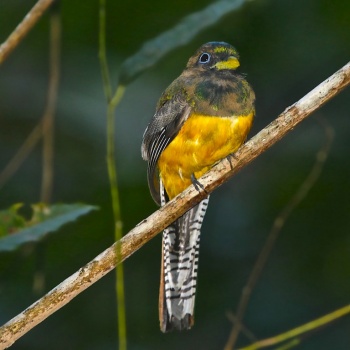- Trogon tenellus
Identification
23.5–26 cm (9-9¾ in)
Male
- Head, and mantle coppery green
- Throat and face black
- Rump plain green
- Uppertail blue to green, with narrow black terminal band; no subterminal band
- Breast golden-green
- Belly yellow
- White band separating yellow belly from breast is complete in most, with some showing incomplete and few showing absence
- Undertail barred black and white, 4-5 bars per cm
- Wing coverts black and white with about 10-11 bars per cm
- Bill yellow (photos indicate darker central underside of lower mandible)
- Eye-ring pale blue to greyish, more prominent in front of and behind the eye
Female
- Head, upper breast and back brown with yellowish tones
- Uppertail Rufous-brown
- Yellow belly
- Undertail barred black and white with 3-5 bars per cm; black bars usually narrower than white
- Undertail in most birds infused with brown basally, a few along edges, some without
- Bill variable from mostly yellow to mostly black or dusky
- Eye-ring blue-grey or blue, wider behind and in front of the eye
Juvenile similar to female but duller, with usually dark bill. Males in their next plumage can look like a dull version of a male or can have brown feathers intermixed with feathers carrying male colors.
Similar species

Photo by Stanley Jones
Bosque del Río Tigre Lodge, Osa Peninsula, Puntarenas Province, Costa Rica, February 2015
Similar species with overlapping range differ in having full black hood in the male (Black-headed Trogon) or by having yellow eye-rings (Gartered Trogon). Choco Black-throated Trogon differs from Northern Black-throated Trogon in having on average slightly blacker tail undersides, yellow eye-ring, and different voice (usually longer series of notes given at a slightly slower pace and with a slightly lower pitch).
Distribution

Photo by Stanley Jones
Pipeline Road, northwest of Gamboa, Colon Province, Panama, 10 February 2018
Tropical south-eastern Honduras to extreme north-western Colombia
Taxonomy
Black-throated Trogon was in 2024 split into four species:
- Northern Black-throated Trogon - Tropical south-eastern Honduras to extreme north-western Colombia
- Choco Black-throated Trogon - Tropical western Colombia and western Ecuador
- Amazonian Black-throated Trogon - Amazonian South America from eastern Colombia, Ecuador, and Peru to Amazonian Venezuela and the Guianas, as well as to Amazonian Brazil
- Atlantic Black-throated Trogon - northeastern Brazil to Paraguay and northeastern Argentina
Subspecies
This is a monotypic species[1].
Habitat
Mostly humid forest and older second growth, but can occasionally be found in dry forest in Costa Rica. Mostly in lowland, but in specific areas found up to 1200-1300 m asl.
Behaviour
Food consists of fruit and insects, with insects more important than in most trogon species. These are captured with the bird sallying out from a perch. Usually the bird is found in the low to middle levels of the forest.
Vocalisation
Notes with a whistled quality are given in series of 2 - 6 (average 3). Around two notes are given per second.
References
- Clements, J. F., P. C. Rasmussen, T. S. Schulenberg, M. J. Iliff, T. A. Fredericks, J. A. Gerbracht, D. Lepage, A. Spencer, S. M. Billerman, B. L. Sullivan, and C. L. Wood. 2023. The eBird/Clements checklist of Birds of the World: v2023. Downloaded from https://www.birds.cornell.edu/clementschecklist/download/
- Gill, F, D Donsker, and P Rasmussen (Eds). 2023. IOC World Bird List (v 13.2). Doi 10.14344/IOC.ML.13.2. http://www.worldbirdnames.org/
- van Dort, J. and P. Pyle (2023). Northern Black-throated Trogon (Trogon tenellus), version 1.0. In Birds of the World (T. S. Schulenberg and M. A. Bridwell, Editors). Cornell Lab of Ornithology, Ithaca, NY, USA. https://doi.org/10.2173/bow.bkttro7.01
- Paper discussing the taxonomy of the former members of Black-throated Trogon
Recommended Citation
- BirdForum Opus contributors. (2025) Northern Black-throated Trogon. In: BirdForum, the forum for wild birds and birding. Retrieved 29 April 2025 from https://www.birdforum.net/opus/Northern_Black-throated_Trogon
External Links
GSearch checked for 2020 platform.1





